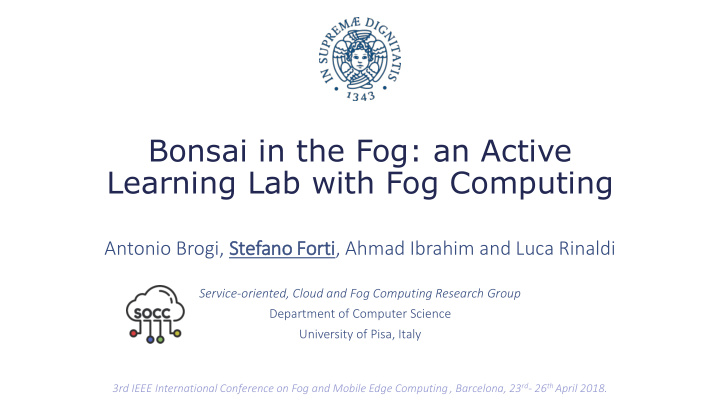



Bonsai in the Fog: an Active Learning Lab with Fog Computing Antonio Brogi, Stefano Fort orti, Ahmad Ibrahim and Luca Rinaldi Service-oriented, Cloud and Fog Computing Research Group Department of Computer Science University of Pisa, Italy 3rd IEEE International Conference on Fog and Mobile Edge Computing , Barcelona, 23 rd - 26 th April 2018.
Deployment Models Cloud • Not sufficient per se to support the IoT mo momentu tum Internet alone. • There is a need for filt lterin ing and pr proc ocessin ing before the Cloud. M2M/ LAN/WAN • Processing should occur wherever it is best-pla laced ed for any given IoT application IoT+ T+Edge IoT+Clo loud • Low latencies, but • Huge computing power, but • Limited capabilities, • Mandatory connectivity, • Difficulties in sharing data • High latencies, • Bandwidth bottleneck.
Deployment Models Cloud Internet Cloud Fog computing is a system-level horizontal architecture that distributes resources and services of computing, storage, control and M2M/ networking anywhere along the continuum from LAN/WAN Cloud to Things , thereby accelerating the velocity of decision making . Fog -centric architecture serves a specific subset of business problems that cannot be successfully Fog implemented using only traditional cloud based IoT+ T+Edge architectures or solely intelligent edge IoT+Clo loud devices . • Low latencies, but • Huge computing power, but • Limited capabilities, • Mandatory connectivity, [ OpenFog Reference Architecture , 2016.] • Difficulties in sharing data. • High latencies, • Bandwidth bottleneck.
Fog Characteristics Context- & Low latency & Pervasiveness & location-awareness bandwidth savings geo-distribution Fog & Things Heterogeneity Mobility of devices
Fog Computing in Education? • is calling for design of courses that include Fog computing in higher education programs. • We introduced Fog computing in our Advanced Software Engineering course ( 2 hours lec lectu ture and 2 hours activ tive learnin ing lab ab ).
Our goals • Design an active learning lab that had to: First hand hands-on on expe xperience Qui Quick lear arning cur curve ve and Limi Limited cos osts and and act active lear arning two-hours time cro cross-platform
Use Case
Multi(functional)Lab BYOD Wi-fi Projector
micro:bits • Programmable with an online editor either with blocks or in Ja JavaScri ript. • Cr Cross ss-platform rm. • Cost around €20 ☺ …
* The ingredients
Activity Plan Set-up of an IoT oT te testb tbed and Coding of a gate gateway mod module Ex Extensions to the gateway simple Edge application to stream/visualise data to module to perform more (IoT oT+Edge ) the Cloud (IoT+Cloud) computation (Fog og)
Active Learning Discussion Tutorial Checkpoint Teamwork
App Collector Collector Collector Radio serial radio Internet Collector Gateway Dashboard (serial) https://github.com/di-unipi-socc/bonsaifog
Collector v1 • Measure mois oisture of one bonsai. • Plots the his histogram to the micro:bit LEDs. • When A pressed: shows mea easurement.
IoT+Edge
Collector v2 • Measure moisture of one bonsai. • Plots the histogram to the micro:bit LEDs. • When A pressed: shows measurement. • Streams data to the radio dashboard at the instructor’s laptop every second. • (Streams data to serial port at students ’ laptop.)
Radio Dashboard • Every time a client connects, a LED is turned on. • Brightness of the LEDs depends on soil moisture of the associated bonsai. • Receives data from Collector clients. • Streams data to the serial port of the instructor’s laptop.
Gateway v1 • Receives and parse data from serial. • Streams data to ThingSpeak.
ThingSpeak • A Cloud service featuring MATLAB analytics and data visualisation for IoT data. • Playtime ☺
Problem or opportunity?
Where is the Fog?
What can we make foggy ? 25
Idea #1 Aggregate data and send an average every 10 seconds. 26
Idea #2 Send data only if the difference between previous average is greater than a threshold. 27
Idea #3 Send data only if the difference between previous average is greater than a threshold. Send it anyhow, if no data hasn’t been sent for 1 hour. 28
Related Work • Literature focus either on - Iot ot+Edge e.g., (Shultz et al., 2015), Arduino, (Abraham, 2016), Raspberry Pi, IoT as a platform, (Wu and Zeng, 2016), simulated environments (Jang et al., 2017) - IoT oT+Cloud e.g., (Kortuem et al., 2013), IoT-based Cloud apps (Patil et al., 2016). Our goal was to showcase Fog computing and highlight the differences with respect to other deployment models for the IoT.
Concluding Remarks ✓ ✓ ✓ First han hands-on on expe xperience and act active lear arning ✓ • Practically understand ✓ Fog computing. • Show differences with alternative deployment models.
Concluding Remarks • Use of high-level language. • JavaScript everywhere. • Very good online docs. Qui Quick lear arning cur curve ve and two-hours time
Concluding Remarks • Cost is around €30 euro per table. • All platforms supported. • We borrowed micro:bits from Limi Limited cos osts and cro cross-platform pisa.coderdojo.it
Future Work Extend the testbed, increase Test scalability Perform quantitative heterogeneity of devices and and measure effec ectiveness measu easurements protocols. of the lab session. of bandwidth savings.
Bonsai in the Fog: an Active Learning Lab with Fog Computing Antonio Brogi, Stefano Fort orti, Ahmad Ibrahim and Luca Rinaldi Service-oriented, Cloud and Fog Computing Research Group Department of Computer Science University of Pisa, Italy 3rd IEEE International Conference on Fog and Mobile Edge Computing , Barcelona, 23 rd - 26 th April 2018.
Recommend
More recommend